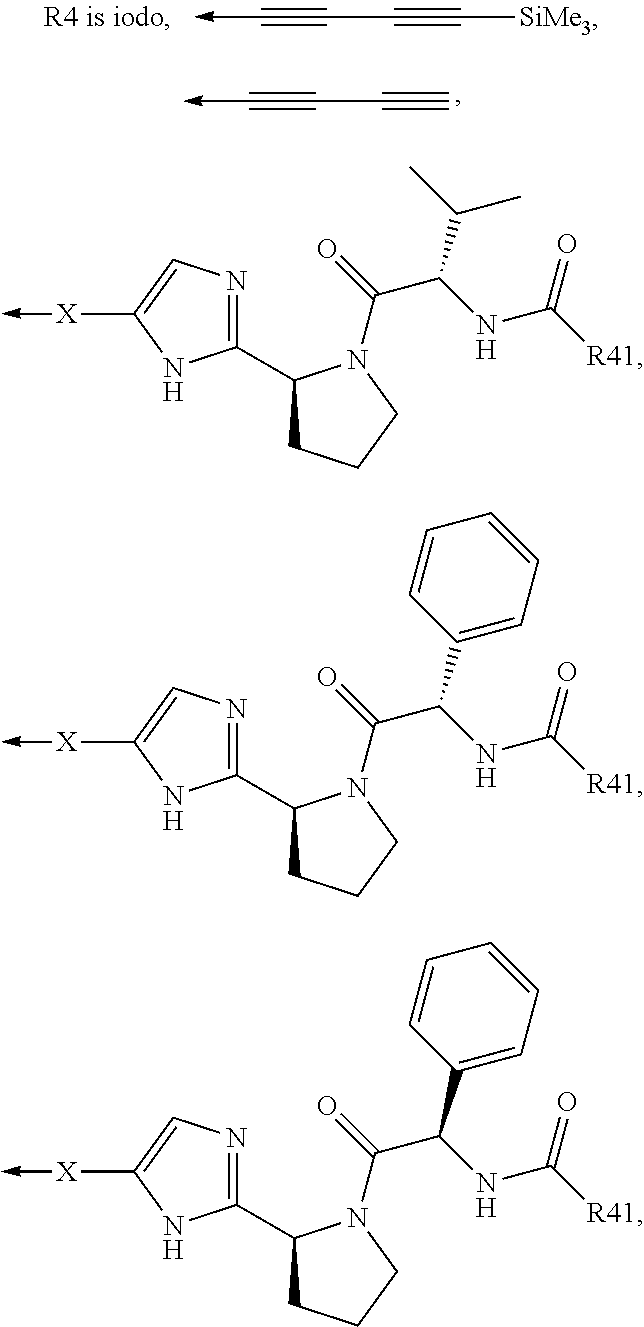Pan-genomic inhibitors of NS5A protein encoded by HCV, pharmaceutical compositions, intermediates for inhibitor synthesis, and their synthesis and application methods
a technology of hcv and ns5a, which is applied in the field of pan-genomic inhibitors of ns5a protein encoded by hcv, can solve the problems of known inhibitors having drawbacks, and achieve the effects of inhibiting the metabolism of known inhibitors, increasing bioavailability, and reducing the risk of infection
- Summary
- Abstract
- Description
- Claims
- Application Information
AI Technical Summary
Problems solved by technology
Method used
Image
Examples
example 1
(Scheme 7). Synthesis of tert-butyl (S)-2-[5-(3-aryl-4-iodo-phenyl)-1H-imidazol-2-yl]-pyrrolidine-1-carboxylate (3(1)-3(6))
[0190]A mixture of N-(4-acetyl-2-bromophenyl)acetamide (10) (2.56 g, 10 mmol), phenylboronic acid (11) (1.463 g, 12 mmol), Na2CO3 (3.18 g, 30 mmol) and bis(triphenylphosphine)palladium(II) dichloride (0.35 g, 0.5 mmol) in 25 mL of ethanol and 5 mL of water was stirred under Ar at 80° C. for 15 h. After the reaction was completed (LC-MS check), the cooled mixture was rotovapped from ethanol, diluted with water and extracted with DCM. Column chromatography on silica gel (hexane:EtOAc 3:2) afforded the product. The yield of N-(5-acetylbiphenyl-2-yl)acetamide (17) is 2.28 g (90%). 1H NMR (DMSO-d6, 400 MHz) δ 9.34 (s, 1H), 7.93 (dd, J1=8.4 Hz, J2=2.0 Hz, 1H), 7.83 (d, J=2.0 Hz, 1H), 7.79 (d, J=8.4 Hz, 1H), 7.49 (m, 2H), 7.43 (m, 3H), 2.59 (s, 3H), 1.94 (s, 3H). Similarly, N-(5-acetyl-4′-methyl-biphenyl-2-yl)-acetamide (18), LC-MS (ESI) 268 (M+H)+; N-(5-acetyl-3′-tert...
example 2
(Scheme 8). Synthesis of methyl ((S)-1-{(S)-2-[5-(3-aryl-4-iodo-phenyl)-1H-imidazol-2-yl]-pyrrolidine-1-carbonyl}-2-methyl-propyl)-carbamates 3(7)-3(16)
[0195]The procedure given above for compounds 35-40 (Example 1) and in the paper by S. Pasaribu and L. Williams [Austr. J. Chem. (1975), 28(5), 1023-1030] was applied for the synthesis of (S)-2-[2-(3-bromo-4-nitrophenyl)-2-oxoethyl]1-tert-butyl pyrrolidine-1,2-dicarboxylate (42). 1H NMR (CDCl3, 400 MHz) δ 8.26 (s, 1H), 7.97 (m, 1H), 7.92 (m, 1H), 5.34 (m, 2H), 4.45 (m, 1H), 3.52 (m, 2H), 2.30 (m, 2H), 2.05 (m, 1H), 1.96 (m, 1H), 1.46, 1.47 (2s, 9H).
[0196]The procedure given above for compounds 3(1)-3(6) (Example 1) was used for the synthesis of (S)-tert-butyl 2-[5-(3-bromo-4-nitrophenyl)-1H-imidazol-2-yl]pyrrolidine-1-carboxylate (43). LC-MS (ESI) 438 (M+H)+. 1H NMR (DMSO-d6, 400 MHz) δ 12.25 (m, 1H), 8.21 (s, 1H), 8.03 (d, J=8.4 Hz, 1H), 7.93 (d, J=8.4 Hz, 1H), 7.88 (m, 1H), 4.80 (m, 1H), 3.54 (m, 1H), 3.37 (m, 1H), 2.24 (m, 1H), 1....
example 3
(Scheme 9). Synthesis of (S)-tert-butyl 2-[5-(5-fluoro-6-iodobiphenyl-3-yl)-1H-imidazol-2-yl]pyrrolidine-1-carboxylate (3(15)-3(17))
[0201]A mixture of 2-bromo-6-fluoro-4-methylaniline (66) [WO 2007036715] (7.28 g, 35.7 mmol), phenylboronic acid (5.53 g, 45.4 mmol), Na2CO3 (11.4 g, 107 mmol), bis(triphenylphosphine)palladium(II) dichloride (1.255 g, 1.8 mmol) in 100 mL of ethanol, and 25 mL of water was stirred under Ar at 80° C. for 15 h. After the reaction was completed (LC-MS check), the cooled mixture was rotovapped from ethanol, diluted with water, and extracted with DCM. Column chromatography on silica gel (hexane:EtOAc 19:1) afforded 3-fluoro-5-methylbiphenyl-2-amine (67). 1H NMR (DMSO-d6, 400 MHz) δ 7.44 (m, 4H), 7.36 (m, 1H), 6.88 (d, J=12.0 Hz, 1H), 6.70 (s, 1H), 4.43 (s, 2H), 2.20 (s, 3H).
[0202]To a solution of 67 (5.0 g, 24.8 mmoL) and TsOH H2O (14.18 g, 74.5 mmol) in 100 mL of tert-BuOH, a solution of NaNO2 (3.43 g, 49.7 mmol) and KI (10.31 g, 62.1 mmol) in 15 mL of wate...
PUM
| Property | Measurement | Unit |
|---|---|---|
| temperature | aaaaa | aaaaa |
| temperature | aaaaa | aaaaa |
| temperature | aaaaa | aaaaa |
Abstract
Description
Claims
Application Information
 Login to View More
Login to View More - R&D
- Intellectual Property
- Life Sciences
- Materials
- Tech Scout
- Unparalleled Data Quality
- Higher Quality Content
- 60% Fewer Hallucinations
Browse by: Latest US Patents, China's latest patents, Technical Efficacy Thesaurus, Application Domain, Technology Topic, Popular Technical Reports.
© 2025 PatSnap. All rights reserved.Legal|Privacy policy|Modern Slavery Act Transparency Statement|Sitemap|About US| Contact US: help@patsnap.com



